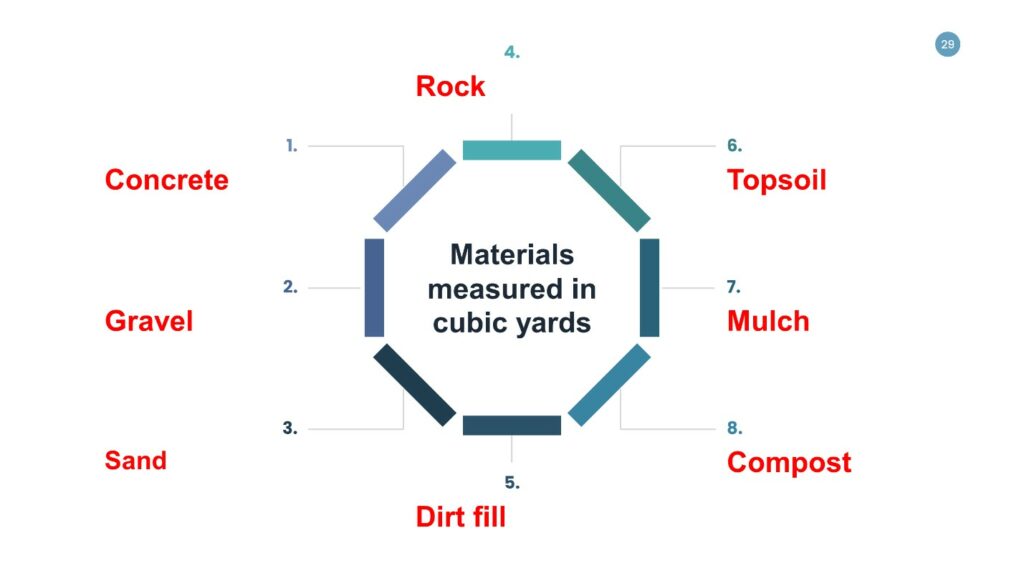Cubic Yard Calculator | Calculate Total Cubic Yards
Articles, products, and services offered on this site are for informational purposes only. We are part of the Amazon Services LLC Associates Program, an affiliate advertising program. Amazon.com is compensated for sales resulting from links on our website.
Please review our disclaimer before acting based on anything you read or see.
The cubic yard is one of the most well-known, oldest, and non-standard units based on imperial/US customary measuring systems. It is used to measure material volume and is popular in the United States and Canada. It is unusual in many European and Asian nations, including Bangladesh, Pakistan, and India. The majority of nations in the globe also use their SI standard unit to measure material volume in cubic meters and liters. This can be quite complex. Thus, we have made this post on Cubic Yard Calculator.
If you offer a variety of commodities, a cubic yard calculator could come in handy. It will also be a relief for your clients if you provide building, gardening, or other services that include concrete, gravel, sand, or dirt. This tool simplifies estimating the supplies needed for your home building, remodeling, or gardening tasks. Come along as we elaborate more on this below.
What is a Cubic Yard?
A cubic yard is the capacity of a cube having dimensions of one yard in length, breadth, and height. Typically, this is 3 feet or 36 inches. 27 cubic feet make up one cubic yard. The combined volume of two washing machines will help you visualize this: a little over a cubic yard.
Dumpster volume is measured in cubic yards due to its form. You may determine the appropriate container size for your task by calculating cubic yards and determining how many things you have.
How to Calculate a Cubic Yard
Before calculating the volume to convert to cubic yards, you must determine the area in inches or feet. To calculate your volume in yards, follow these steps:
- Calculate the area in feet.
- Establish the material’s depth. This may be mulch, which you would spread over this area with a typical depth of inches.
- Convert every measurement you have to feet.
- Skip to “Calculate” if you merely measured in feet.
- To get the total number of feet, multiply your feet measurement by 12 inches.
- Determine the cubic yards.
Cubic Yard Calculator
Steps to Calculate Cubic Yards
When managing huge quantities of commodities, cubic yards often take the role of cubic feet as the nation’s standard unit. Since the resultant computations are smaller and easier to handle, this applies to concrete slabs, mulch, and dirt. As an illustration, a contractor may more easily picture, recall, and communicate “12 cubic yards” instead of “324 cubic feet.” Frequent managers of such materials will often refer to the unit simply as “yards,” but doing so wrongly suggests that it measures length rather than volume.
You can Calculate Cubic Yards through the following steps:
Determine the area’s feet-based length, breadth, and height.
For now, utilize inches for any leftovers or measures shorter than one foot. A planned driveway, for instance, maybe 6 inches high, 20 feet broad, and 31 feet 9 inches long.
Multiply any inches-based numbers by 12.
This will help you translate them into feet and guarantee that each measurement is accurate. To convert 6 inches to 0.5 feet in the instance height, divide the value by 12. Divide the inches by 12 and add the resultant decimal to the feet measurement if the metric is in feet and inches. The length in the example is converted to 31.75 feet by dividing 9 inches by 12 and adding the resultant 0.75 decimal.
To get the volume in cubic feet, multiply the three measures.
In the above example, adding 0.5 to 20 and then to 31.75 yields 317.5 cubic feet.
To convert the value to cubic yards, divide the amount by 27.
Since your supplier is unlikely to offer you a fraction of a cubic yard, round the result up to the next full number, it’s usually preferable to have a little more stuff than you need instead of needing more. The above example calculates the volume as 11.76 cubic yards by dividing 317.5 by 27, which squares up to 12 cubic yards.
How to Convert Square feet to Cubic Yards
You can transform Sq. Ft to Cubic Yards through the following infographic:

Materials measured in cubic yards
The amount of stuff that can fit in an area one yard wide by one yard deep by one yard high is measured in cubic yards. The following are the most typical materials, as measured in cubic yards:

Note that only the materials used most often are included in this list. The whole list might go on forever since many different materials and areas exist.
How much will my cubic yard of materials weigh?
You’ll need to perform a conversion to know how much your cubic yard of stuff could weigh in tons, kilograms, or pounds. We must do this since the cubic yard is a measure of volume. And a unit of weight is a ton, kilogram, or pound. You’ll need to know the substance’s density to translate between the two. To use an extreme example, a cubic yard of plumage will weigh far less overall than a cubic yard of sand.
Frequently Asked Questions
How many square feet are covered by a cubic yard?
100 square feet (1010-foot area) of materials may be covered using a cubic yard spread out at three inches of depth.
What is 1 cubic yard equal to in feet?
A cubic yard is the size of a cube having dimensions of one yard in length, breadth, and height (3 feet or 36 inches). 27 cubic feet make up one cubic yard.
How many cubic yards are 1000 square feet?
According to general rules and recommendations, you will require around 12.5 cubic yards of marble for a 1000 square foot (sq. ft.) slab or a (25 40) slab at a 4-inch thickness. And you would be needed since the concrete would be 15.5 yards long and 5 inches thick.
How much ground will a cubic yard cover?
100 square feet are covered by one cubic yard of dirt at a 2-inch depth.
What is the difference between a yard and a cubic yard?
A yard defines a two-dimensional area, whereas a cubic yard measures a space’s capacity in three dimensions.
How much does 10 cubic yards of concrete cover?
The area that 10 cubic yards of regular weight or mix or broken concrete will fill at 3 inches deep is 1080 square feet.
How do you convert cubic yards to square yards?
You cannot convert between square meters and cubic yards since they are units for quite new aspects. A cubic yard is a capacity unit, while a square yard measures area.
Expert Opinion
An area 3 feet long, 3 feet wide, and 3 feet high is called a cubic yard. It is a common and widely used Imperial/US conventional unit of volume that is mostly used in the US and Canada. Making use of the cubic yard calculator makes this simple.
Without a calculator, you may compute cubic yards by multiplying the width by the depth by the height, just as you would for any other volumetric measurement. Make careful you measure everything in yards.
Convert all measures to feet, double the result to obtain the volume in cubic feet, then split the result by 27 to get the amount in cubic yards to get the cubic rushing yards of inches or another unit of measure.



Comments are closed.